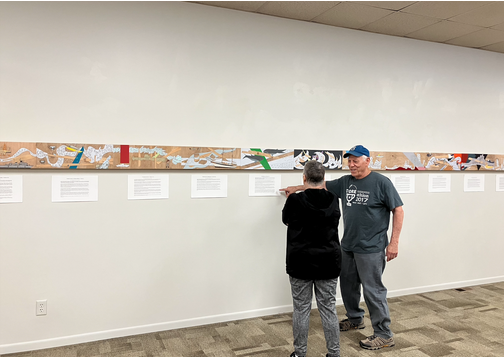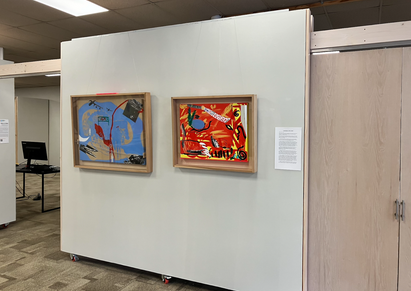Community engagement is vital—now more than ever—for fostering a more inclusive understanding of the liberal arts and sciences in this current world. Following a brief hiatus during the early years of the COVID-19 pandemic, the CLA Engagement Hub (located in Pillsbury Hall) began hosting residencies in 2021-2022. Scholars from the university have since partnered with community members to promote shared interests within the public spaces of both Pillsbury Hall and the larger Twin Cities metro.
In this piece, we are highlighting a recent public art exhibition that features one of the current Engagement Hub residents, Voice to Vision. Professor Feinberg also holds a CLA Engagement Hub residency for the 2022-2023 academic year, and is continuing his collaborative project with various storytellers with connections to the Twin Cities.
The gallery exhibition included works from Voice to Vision, a series of collaboratively-produced works of art with survivors of genocide and mass violence from around the world. The various series bring together multiple artistic subjects simultaneously, and they put into dialogue different voices, historical events, and intergenerational memory.
The Engagement Hub is not the only recent venue displaying Voice to Vision artworks. On September 9th and 10th, 2022, the East Side Arts Council organized the Solidarity Street Gallery in Saint Paul’s Payne-Phalen neighborhood. This year’s festival was the third of its kind, and the title, “Resilient Generations,” pointed to the lived experiences in East Saint Paul’s many Southeast Asian communities. As the event description also highlighted, the galleries, events, and culinary pop-ups not only feature the ways language, memory, and culture continue across generations; they also serve as a call for solidarity against anti-Asian violence that has only become more severe in the past several years.
Payne-Phalen is the largest of Saint Paul’s neighborhoods. Located north and slightly east of downtown, the region has long been a center for migration, and the architecture, place names, and businesses reflect this history. The Solidarity Street Gallery included both a curated gallery exhibition as well as street galleries that profiled public art on display throughout the year.
One of the most striking pieces from Voice to Vision that also appeared in Feinberg’s retrospective that marked his retirement was Voice to Vision XI. Consisting of twelve pieces that form the shape of a large boat, each panel is the product of an individual storyteller’s experiences shaped by the Vietnam War and its aftermath. No two panels being alike causes the viewer to confront the realities of survivor testimony: points of view are varied, subjective, and not monolithic, and only in recognizing lived, human experience as such can we grapple with the past often told through monumental narratives.

The galleries varied in terms of location. Some were located in former office spaces, while others could be found inside the many local businesses along Payne Avenue, which allowed visitors to not only engage with the diverse commercial spaces in the neighborhood but also see the ways art blurred the boundaries between public and personal.

We at CHGS encourage you to browse the incredible roster of residencies for the 2022-23 academic year. For more information on Voice to Vision, please visit either our collections page, or the UMN LIbraries’ Digital Conservancy.
Meyer Weinshel completed his PhD in Germanic Studies at the University of Minnesota. He is Head of Programming, Publications, and Research at the Center for Austrian Studies, and the Collections Curator for the Center for Holocaust & Genocide Studies. From 2021-2022, he was a Co-PI (and later postdoctoral researcher) for the Minnesota Human Rights Archive project (MHRA). He also taught German studies coursework in the UMN Department of German, Nordic, Slavic & Dutch (GNSD) from 2015-2020, and served as a visiting lecturer of Yiddish studies in the Ohio State University’s Department of Germanic Languages and Literatures in 2021. From 2018 to 2020, he was also involved with various Yiddish pedagogy initiatives at the Yiddish Book Center (Amherst, MA)—including the piloting of their new textbook, In eynem, working for the Book Center’s Steiner Yiddish Summer Program, and designing and teaching Yiddish community-education courses with Jewish Community Action (Minneapolis, MN). In addition to subject specializations in genocide studies, German studies, Yiddish studies, and Jewish studies, he also researches LGBTQIA+ histories, memory, translation, and migration.

Comments